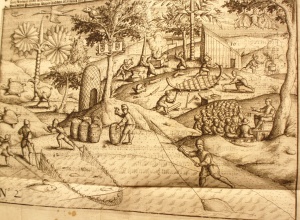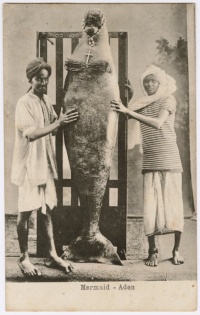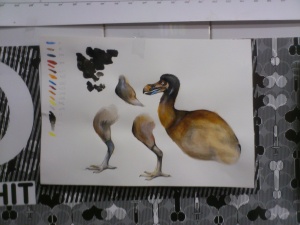Niek: Difference between revisions
No edit summary |
No edit summary |
||
| Line 32: | Line 32: | ||
==4. Literature== | ==4. Literature== | ||
* The Dodo, Erroll Fuller, 2003. | * The Dodo: From Extinction to Icon, Erroll Fuller, 2003. | ||
* The Song of the Dodo, David Quammen, 1997. | * The Song of the Dodo, David Quammen, 1997. | ||
* Return of the Crazy Bird: The Sad, Strange Tale of the Dodo, 2003. | * Return of the Crazy Bird: The Sad, Strange Tale of the Dodo, 2003. | ||
Revision as of 22:48, 1 December 2013
1. The past, the present and the future
Few things are as fuzzy and attractive as the past. It is a concept that is never really present, though it's traces are everywhere. The most appealing bit about it might be it's tangibility. One can never physically encounter in the present what has already happened and that is why it is possible to make things up about it without any ancient characters complaining. The only thing one has to account for within historical practice are the concrete objects that actually bear witness to past events and are now collecting fungi within the recycled air of archives and libraries. In this way, inanimate objects are the stuff historical knowledge is built upon.
Objects that are now used as historical sources were once everyday tools or accounts. They were made and used by actual living beings with thoughts and feelings, but at one point in time they simply stopped being issued. The objects became redundant and landed outside the field of everyday use. Even though the items and persons who used them are not seen on the streets anymore, they still have a very real place within contemporary discourse. Besides their economic value, historians and collectors are attracted and attached to them because of their esthetic value and the stories behind them. It is possible to project feelings and ideas upon them. Sometimes, such ideas lead to very elaborate narrative constructions, which are retold and reshaped over and over again and get new contemporary uses. It often occurs that objects even become part of a brand new ideology or story, either as an icon or as a brand new tool incorporating elements of the past item.
This is possible by means of reissuing which necessarily relies on past objects and sources. Nowadays, different interpretations of an endless variety of subjects can be found on the web and in digital libraries. Each one is equally represented and can be used as material for any sort of reissue. Every alternative to a conclusive past is a starting point for an alternative route that was not taken before. There are for instance certain technologies or philosophies that didn’t catch on in the time when they were proposed, but that are now being used as a speculative approach to the past, present and future. As such, the past appears to be a relative subject outside the reach of a practical 'truth', since it can be bended and shaped by the ‘human mind’, which is the only true contemporary container of memory. However, something gets lost within these new narratives and digital tools contribute to this cultural misinterpretation. The true metaphysical meaning of objects, by which I mean it's particular essence whatever that may be, shifts between romantic speculation and sentimental relativism.
2. Up Close And Personal
One question I continually ask myself is what it means when an object becomes redundant or is being reissued. I'm addicted to looking for uncommon user items and tools and like to use them in my work. This is pretty evident in the VHS projects I worked on during the last year or so. I gave workshops in tape cutting (VHS animation) and organized a talkshow about the sustainability of the medium. However, this concept is also present in my work as a musician, for instance while working with the 'Tip Top Orchestra' where 20th century elitist avant-garde music was repurposed within an contemporary amateur discourse. Furthermore, my work as an art historian has also focussed on the transcendence of images and subjects to icon and object of reflection.
While I am not a psychologist, I think that I am probably attracted to past object because of this undefined characteristics defined in the previous part of this proposal. Furthermore, I wonder what it means to be redundant and reissued myself. I am very much aware during my gloomy days that at one point in time I will die and leave behind traces that might help to construct a narrative. While my living essence, whatever that is, gets lost with me being gone, something else will take it's place. This might be an icon, but it could also be a pluriform identity or even a mere corpse. Something gets lost and something takes it's place by means of a human interest for the past. I wonder what it means to get lost in translation.
This is the question on which I want to focus during my graduation year. To answer it I will look at different approaches to the handling of historical sources, some pre-digital and some that are being enforced by digital tools. I am curious what kind of metaphysical estrangement they constitute and how they do this. Certain specified objects such as dodecaeders, mummies, mermaids, african festishes, the narwal tooth, John Dee's speculum and the image of the dodo will be taken as historical examples of this shifting of meaning and essence. I will delve deeper within the different metaphysical approaches to objects, for instance by means of object orientated ontology and Heideggerian phenomenology. In this way I will be able to specify what exactly gets lost within historical reissuing and if this matters at all. My thesis will be an historical study with a hint of metaphysics this way.
3. Dead as a dodo
My final work will be something that complement my thesis. It will not be a documentation or illustration of the research I have undertake in the months before it, but it will incorporate all this anyway, because I hold an obsessive interest in this matter. I believe the metamorphosis on which I want to focus, specifically the cultural misinterpretation of objects and the problems in essence these constitutes, is something fundamentally human of which many examples can be found. To study these is the best way to start working on a final project and get some grasp on the matter.
I have started my research on the image on the dodo, which is of course both an extinct bird which used to live on Mauritius and an icon for extinction. One of the most startling things about the dodo however, is how few actual remains it has left behind. These can be divided in three groups: written accounts, pictures and ... finds.
and have tried to express some of the issues concerning it's icon-making in a short animated film. Animation is the method I choose for constructing my manipulated narrations, because enforcing my will upon them does not put me in the reflective, relative sphere of the researcher. I'd like to contribute to a discourse with action and that is why I will produce expressive work about specified objects , so that I am also a spot in the history of the object.
I will turn my research into something concrete by means of an installation incorporating sound, image, light and animatronics. Objects of the past are orchestrated and manipulated to narrate a false, mutated history in the form of a 10 minute show bearing similarities to the type that can be found in amusement parks. One important factor in this show is the use of animation, for enforcing your will upon inanimate objects to construct a narrative is the start of any form of essential misinterpretation. This event consists within a triangle of the narrator, narration and reader. When enforced upon an object, we encounter the start of misinterpretation. This entire process will be present in my final work. Everything together will tell the story of the struggle between mankind and it's past and future by means of insensitive objects.
4. Literature
- The Dodo: From Extinction to Icon, Erroll Fuller, 2003.
- The Song of the Dodo, David Quammen, 1997.
- Return of the Crazy Bird: The Sad, Strange Tale of the Dodo, 2003.
- The Follies of Science at the Court of Rudolph II, 1576-1612, Henry Carrington Bolton, 1904.
- Evil Media, Matthew Fuller and Andrew Goffey, 2012.
- Anti-Media: Ephemera On Speculative Arts, Florian Cramer, 2013.
- Remediation: Understanding New Media, Jay David Bolter and Richard Grusin, 2000.
- Tool-Being: Heidegger and the Metaphysics of Objects, Graham Harman, 2002.
- Guerilla Metaphysics: Phenomenology and the Carpentry of Things, Graham Harman, 2005.
- The Democracy of Objects, Levi Bryant, 2011.
- Alien Phenomenology, or What It's Like to Be a Thing, Ian Bogost, 2012.
- Vibrant Matter: A Political Ecology of Things, Jane Bennett, 2009.
- The Media Equation: How People Treat Computers, Television, and New Media Like Real People and Places, B. Reeves, B and C. Nass, 1996.
- Machines and mindlessness: Social responses to computers, C. Nass, C and Y. Moon, 2000.
- You Are Not a Gadget: A Manifesto, Jaron Lanier, 2011.
- The Future Of Nostalgia, Svetlana Boym, 2002.
- When Elephants Weep: The Emotional Lives of Animals, Jeffrey Moussaieff Masson, 1996.
- The Complete Hans Christian Andersen Fairy Tales, Hans Christian Andersen, 1981.
- Sein Und Zeit, Martin Heidegger, 1927.
- The Brave Little Toaster from Print to Film: Obsolescent Appliances and Capitalist Allegories, Margaret D. Stetz, Opticon 1826, 14: 21-26, DOI: http://dx.doi.org/opt.aj, 2012.
- The Brave Little Toaster, Thomas M. Disch, 1980.



